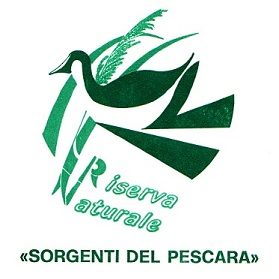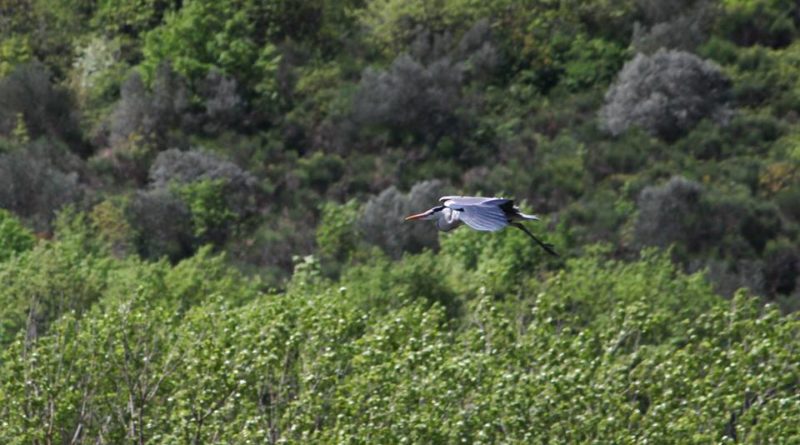🇬🇧 The fauna of the Reserve
The rich fauna of the Pescara Springs Nature Reserve

The most interesting faunal aspect at the Sorgenti del Pescara Nature Reserve is represented by a significant number of ornithic species. About 110 species, both sedentary and migratory, have been counted in the Reserve.
The Coot, present with a large colony, has been chosen as the symbol of the Reserve: its black plumage and white beak and front plate make it easy to identify. Mallard, Little Grebe and Moorhen are also easily observed in the protected area. In the cane thicket the Marsh Harrier sometimes hunts, while in shallower waters the Little Egret and the Little Bittern find food. The Grey Heron, in its migrations, has always passed through the Reserve: in 2010 for the first time it stopped to nest in the reed thicket. The heronry, technical name for colonies of herons such as the Grey Heron, is the first in Abruzzo for this species, which several years ago had tried to nest unsuccessfully in the lake of Penne. It is therefore an absolute novelty for the region.
In the hygrophilous woodland, the River Warbler, the Penduline Tit, the Golden Oriole, the Green Woodpecker, the Red Woodpecker, the Redstart, the Nightingale and other species find their refuge.
Numerous birds of prey can be found in the barren areas of the Colle di Capo Pescara, including the Kestrel, Sparrowhawk and Peregrine Falcon. Also in this area are the Lesser Grey Shrike, the Black-backed Bunting, the Hoopoe and the Nightjar. Among the cultivated areas, the Harrier sometimes hovers during the winter.
Less representative in terms of species present but still rich is the list of mammals present.
Among the rodents, the presence of the Dormouse, the Squirrel, the Garden and Hazel Dormouse was detected. With regard to the muridae, traces of the Wild Mouse, the House Mouse, the Black Rat and the Surmolotto have been found. The terrestrial, Savi’s and reddish voles are present.
In warm, sheltered woods the Badger is found, while the Polecat and the Stone Marten are more ubiquitous. Thermophilous woods are also home to the Porcupine. Among the canids we mention the presence of the Fox, while the Wild Boar occasionally crosses the Reserve area. In broad daylight, the ubiquitous Weasel can be observed, while tracks of the Polecat can often be spotted. Unfortunately, among the mustelids, the otter, once a frequent inhabitant of the lake and neighbouring watercourses, can no longer be found.

Amphibians and reptiles are also represented in the Reserve by various species.
In the transition zones between the humid environment and the thermophilic scrubland of Colle Capo Pescara, the Apennine Salamander, with its yellow and black speckled body, can be found among the urodeles. Puddles of stagnant water and weakly flowing waters are characterised by the presence of the Italian Newt and the Great Crested Newt. Anurans are represented by the Tree Frog, which nimbly clings to the marsh reeds, while the Yellow-bellied Toad is found more rarely. The Common Toad is very common. Frogs include the Agile Frog associated with wet meadows, while the Lesser Green Frog frequents the more easterly swampy areas of the wetland.
In the environments of the Reserve, reptiles are represented by a good variety of species, both saurians and snakes. In the arid areas of the Colle Capo Pescara, the Wall Lizard can be found, while the Field Lizard is common in all the meadows; the Green Lizard lives on the sunniest hillside.
The snake species are diverse and colonise different environments: in the aquatic environment, the Tessellated Grass Snake is found, while the xerobrometeum is home to the Aesculapian Snake, the Whip Snake and the Viper. The presence of the Four-lined Snake is also well known.
In the fresh, oxygenated waters of the spring and in the first stretch of the river, there is a precious treasure trove of species of considerable interest.
Among the salmonids, the Brown Trout still retains its autochthonous characteristics. Of great scientific interest is the presence of the Stickleback, which is in considerable decline in many Italian rivers, and the almost certainly native Rovella. In the canals on either side of the reservoir, there is the Brook Lamprey, a cyclostome that has become extremely rare in Italy and has disappeared in many watercourses: this is a case of extremely rare zoo-geographical interest, because it only lives near the Pescara Springs, if you take into account the arch of the Adriatic.
Among crustaceans, the presence of the Crayfish is certainly worth mentioning. Very common in all the local watercourses until the second half of the 1970s, it risked extinction due to a serious disease caused by the “saprolegnia” fungus, Aphanomyces astaci.
Furthermore, in 2010, Prof. Diana Galassi‘s team of the University of L’Aquila found Niphargus, a species new to science, in the waters of the Pescara Springs. It is a small, blind and depigmented organism that lives in the small living spaces between the sand granules of the spring sediments or near the large karstic springs. No less important, this species and other organisms of the same genus behave as ‘hydrogeological markers‘, and have also made it possible to biologically define the different origins of the groundwater that surfaces in the springs of the Pescara river.
The waters of Santa Liberata and other small adjacent springs originate from the Gran Sasso aquifer, as demonstrated by the chemical and isotopic monitoring conducted on the waters, and host a biodiversity that is very different from that of the Capo Pescara springs, which are instead fed by the mount Sirente ridge. The discovery of these species gives an ‘added value‘ to this internationally important spring ecosystem, and also highlights its extreme vulnerability: this species and other organisms belonging to the same genus are, in fact, particularly sensitive to decreases in flow rate as well as to the clogging of interstitial spaces, produced by human activity in the area. Therefore, the Nature Reserve “Sorgenti del Pescara” represents an important and precious moment of knowledge of biodiversity and encounter with nature.



